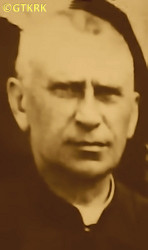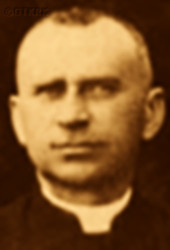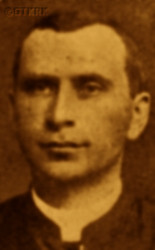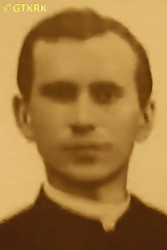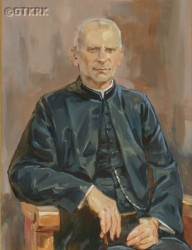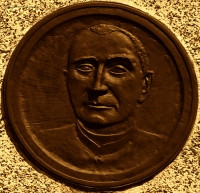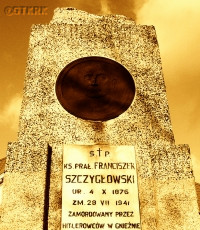Roman Catholic
St Sigismund parish
05-507 Słomczyn
85 Wiślana Str.
Konstancin deanery
Warsaw archdiocese, Poland
full list:
displayClick to display full list

searchClick to search full list by categories
wyświetlKliknij by wyświetlić pełną listę po polsku

szukajKliknij by przeszukać listę wg kategorii po polsku

Martyrology of the clergy — Poland
XX century (1914 – 1989)
personal data
surname
SZCZYGŁOWSKI
forename(s)
Francis (pl. Franciszek)
function
diocesan priest
creed
Latin (Roman Catholic) Church RCmore on
en.wikipedia.org
[access: 2014.09.21]
diocese / province
Włocławek diocesemore on
en.wikipedia.org
[access: 2013.05.19]
Włocławek i.e. Kalisz diocesemore on
pl.wikipedia.org
[access: 2019.10.13]
RC Military Ordinariate of Polandmore on
en.wikipedia.org
[access: 2014.12.20]
honorary titles
Papal super–numerary private chamberlainmore on
en.wikisource.org
[access: 2020.12.11]
Order of Saint Stanislav (Russian Empire) 3rd classmore on
en.wikipedia.org
[access: 2019.10.13]
honorary canonmore on
honorary canon (Assumption of the Blessed Virgin Mary RC collegiate church, Kalisztoday: Kalisz city pov., Greater Poland voiv., Poland
more on
en.wikipedia.org
[access: 2020.12.16])
date and place
of death
27.07.1941

Gnieznotoday: Gniezno urban gm., Gniezno pov., Greater Poland voiv., Poland
more on
en.wikipedia.org
[access: 2021.12.18]
alt. dates and places
of death
28.07.1941
details of death
After the end of World War I and the rebirth of the Polish state on 11.11.1918, Aleksandrów Kujawski found itself on the border of Poland and the German province of Germ. Provinz Westpreußen (Eng. West Prussia) — or more precisely, the Chełmno Land, which was part of the Germ. Provinz Westpreußen — still formally belonging to Germany. And at the turn of 1918/1919, during the Greater Poland Uprising of 1918‐1918, fierce Polish–German fighting took place west of Służewo (where was a vicar, although residing in Aleksandrów). The temporary demarcation line was established north of Aleksandrów. Prob. at that time, according to witnesses' recollections, knowing the local area, became a courier of correspondence and a guide for Polish emissaries between Chełmno Land and, further on, Gdańsk Pomerania, which was also part of the Germ. Provinz Westpreußen, and independent Poland.
At that time, became also a chaplain of one of the units of the Polish Army, which was part of the Pomeranian Front, under the command of General Joseph Haller. The Front's task was to take over part of the Germ. Provinz Westpreußen, granted to Poland under the peace treaty signed in Versailles on 28.06.1919 by the Entente countries and Germany. This took place on 18.01‐11.02.1920, after the ratifications by the contracting parties and the entry into force of the treaty on 10.01.1920.
After German and Russian invasion of Poland in 09.1939 and start of the World War II, after start of German occupation, supported priests interned from 1940 by the Germans in IL Lond transit camp in Ląd, serving among others as a courier for arrested Bp Michael Kozal.
Arrested by the Germans on 07.12.1940.
Jailed in Konin prison.
Next after 7 months moved to Gniezno prison (by Franciscan church).
There perished — tortured and starved.
cause of death
extermination
perpetrators
Germans
sites and events
KoninClick to display the description, IL LondClick to display the description, 26.08.1940 arrests (Warthegau)Click to display the description, Reichsgau WarthelandClick to display the description, Ribbentrop‐MolotovClick to display the description, Pius XI's encyclicalsClick to display the description, Polish‐Russian war of 1919‐1921Click to display the description
date and place
of birth
04.10.1875

Radomskotoday: Radomsko gm., Radomsko pov., Łódź voiv., Poland
more on
en.wikipedia.org
[access: 2021.12.18]
alt. dates and places
of birth
26.09.1876, 07.09.1876, 04.10.1876
parents
SZCZYGŁOWSKI John
🞲 ?, ? — 🕆 ?, ?

ZAŁĘSKA Julianna
🞲 ?, ? — 🕆 ?, ?
presbyter (holy orders)
ordination
27.05.1900

Włocławektoday: Włocławek city pov., Kuyavia‐Pomerania voiv., Poland
more on
en.wikipedia.org
[access: 2021.12.18]
positions held
1920 – 1939
dean — Słupcatoday: Słupca gm., Słupca pov., Greater Poland voiv., Poland
more on
en.wikipedia.org
[access: 2021.12.18] RC deanery
1920 – 1940
parish priest — Słupcatoday: Słupca gm., Słupca pov., Greater Poland voiv., Poland
more on
en.wikipedia.org
[access: 2021.12.18] ⋄ St Lawrence the Deacon and Martyr RC parish ⋄ Słupcatoday: Słupca gm., Słupca pov., Greater Poland voiv., Poland
more on
en.wikipedia.org
[access: 2021.12.18] RC deanery — also: organizer of Polish education in the parish: founder of a primary school, the Marshal Joseph Piłsudski State Teachers' Seminary and in 1925 of the Coeducational Secondary Trade School of the Polish School Association; in the latter also a prefect; member — vice‐president and president — of the Polish School Association in Słupca
1919 – 1920
RC auxiliary military chaplain — Aleksandrów Kujawskitoday: Aleksandrów Kujawski gm., Aleksandrów Kujawski pov., Kuyavia‐Pomerania voiv., Poland
more on
en.wikipedia.org
[access: 2020.12.16] ⋄ Northern Front, Polish Armed Forces — by L. 2845 decree of the Commander‐in‐Chief of 14.04.1921, at the request of the Bishop's Curia of the Polish Army, demobilised from the Polish Army
1917 – 1920
parish priest — Aleksandrów Kujawskitoday: Aleksandrów Kujawski gm., Aleksandrów Kujawski pov., Kuyavia‐Pomerania voiv., Poland
more on
en.wikipedia.org
[access: 2020.12.16] ⋄ Transfiguration of the Lord RC parish ⋄ Nieszawatoday: Nieszawa gm., Aleksandrów Kujawski pov., Kuyavia‐Pomerania voiv., Poland
more on
en.wikipedia.org
[access: 2020.11.05] RC deanery
c. 1918 – c. 1920
mayor — Aleksandrów Kujawskitoday: Aleksandrów Kujawski gm., Aleksandrów Kujawski pov., Kuyavia‐Pomerania voiv., Poland
more on
en.wikipedia.org
[access: 2020.12.16] — during the rebirth of the Republic of Poland
1913 – 1920
director — Aleksandrów Kujawskitoday: Aleksandrów Kujawski gm., Aleksandrów Kujawski pov., Kuyavia‐Pomerania voiv., Poland
more on
en.wikipedia.org
[access: 2020.12.16] ⋄ Realgymnasium — also: founder and organiser of the school building construction
1907 – 1917
vicar — Aleksandrów Kujawskitoday: Aleksandrów Kujawski gm., Aleksandrów Kujawski pov., Kuyavia‐Pomerania voiv., Poland
more on
en.wikipedia.org
[access: 2020.12.16] ⋄ Transfiguration of the Lord RC chapel ⋄ Służewotoday: Aleksandrów Kujawski gm., Aleksandrów Kujawski pov., Kuyavia‐Pomerania voiv., Poland
more on
en.wikipedia.org
[access: 2020.12.16], St John the Baptist RC parish ⋄ Nieszawatoday: Nieszawa gm., Aleksandrów Kujawski pov., Kuyavia‐Pomerania voiv., Poland
more on
en.wikipedia.org
[access: 2020.11.05] RC deanery — also: chaplain at a border railway station — between the Russian Empire and from 1915 the Polish territories occupied by the Germans, i.e. the Germ. Königreich Polen (Eng. Polish Kingdom), and the German Empire; then from 1918 between Germany and Poland; prefect of primary schools; organizer of courses and Polish education — after the escape of the Russians in 1915, i.e. the so‐called bezhenstvo, during World War I
1902 – 1907
vicar — Służewotoday: Aleksandrów Kujawski gm., Aleksandrów Kujawski pov., Kuyavia‐Pomerania voiv., Poland
more on
en.wikipedia.org
[access: 2020.12.16] ⋄ St John the Baptist RC parish ⋄ Nieszawatoday: Nieszawa gm., Aleksandrów Kujawski pov., Kuyavia‐Pomerania voiv., Poland
more on
en.wikipedia.org
[access: 2020.11.05] RC deanery
1902
vicar — Rozprzatoday: Rozprza gm., Piotrków Trybunalski pov., Łódź voiv., Poland
more on
en.wikipedia.org
[access: 2020.11.05] ⋄ Visitation of the Blessed Virgin Mary. St Stanislav the Bishop and Martyr and St Bartholmew the Apostle RC parish ⋄ Piotrków Trybunalskitoday: Piotrków Trybunalski city pov., Łódź voiv., Poland
more on
en.wikipedia.org
[access: 2021.07.29] RC deanery
1901 – 1902
vicar — Grocholicetoday: district of Bełchatów, Bełchatów urban gm., Bełchatów pov., Łódź voiv., Poland
more on
en.wikipedia.org
[access: 2021.12.18] ⋄ All the Saints RC parish ⋄ Piotrków Trybunalskitoday: Piotrków Trybunalski city pov., Łódź voiv., Poland
more on
en.wikipedia.org
[access: 2021.07.29] RC deanery
1900 – 1901
vicar — Wilczyntoday: Wilczyn gm., Konin pov., Greater Poland voiv., Poland
more on
en.wikipedia.org
[access: 2020.12.16] ⋄ St Ursula the Virgin and Martyr RC parish ⋄ Słupcatoday: Słupca gm., Słupca pov., Greater Poland voiv., Poland
more on
en.wikipedia.org
[access: 2021.12.18] RC deanery — also: prefect of elementary schools
1895 – 1900
student — Włocławektoday: Włocławek city pov., Kuyavia‐Pomerania voiv., Poland
more on
en.wikipedia.org
[access: 2021.12.18] ⋄ philosophy and theology, Theological Seminary
sites and events
descriptions
Konin: The prison founded by the Russians during the partitions of Poland, right after the January Uprising of 1863‐1864. The Russians detained and murdered there, among others the leader of the uprising in Konin, a Capuchin monk, Fr Maximilian Tarejwa. In 09.1939, after the start of World War II, the Germans took it over and used it as a prison and a detention center. Many Poles were held there — incl. hostages, who were later shot on 10.11.1939 in the Jewish cemetery. C. 180‐200 people were held in 24 cells (12 in the basement and 12 on the ground floor) at any one time. Together, several thousand Poles passed through the prison. After the end of hostilities of the World War II and the beginning of the Russian occupation, in the years 1945‐1956 the Commie‐Nazi authorities of the People's Republic of Poland prl murdered at least 10 people in prison. (more on: lajt.lm.plClick to attempt to display webpage
[access: 2010.08.11])
IL Lond: The Gestapo District Office in Poznań issued on 13.12.1939 executive instruction Ref. IIB No. 406/39 Tgb. No. 3045/39, ordering: „Based on the regulation of the Germ. Höherer SS‐ und Polizeiführer (Eng. Higher Commander of the SS and Police) [of the German province of Warthegau (Eng. Greater Poland)] of 12.11.1939 [SS‐Gruppenführer Wilhelm Koppe], apart from Poles and Jews, also Catholic clergy will be expelled. Action against this group of people should be carried out in such a way that internment and transport are separate […] C. 80% of Catholic clergy are expected to be expelled. The selection based on political threat posed. Internees cannot be placed in regular transit camps due to the possibility of international protest. Catholic clergy should be interned in men's monasteries and held there till mass transportation out”. And so in 1940‐1941, in a formerly Cistercian priory and monastery (today Salesian Institute) in Ląd on Warta river Germans set‐up a transit Germ. „Internierungslager” (Eng. „Internment camp”) for Polish priests and religious, from Włocławek, Gniezno, Warszawa, Poznań, Płock and Częstochowa dioceses and religious and monks from a number of congregations. Approx. 152 religious (70 till 03.04.1941 and 82 in 06‐28.10.1941) were held there prior to being sent to KL Dachau concentration camp. After the deportation, the Germans organized a training center for the German National Socialist youth wing, Germ. „Hitler‐Jugend” (Eng. „Hitler youth”), in the abbey. (more on: pl.wikipedia.orgClick to attempt to display webpage
[access: 2013.08.10], yadda.icm.edu.plClick to attempt to display webpage
[access: 2016.03.14])
26.08.1940 arrests (Warthegau): As part of the Germ. „Ohne Gott, ohne Religion, ohne Priesters und Sakramenten” (Eng. „without God, without religion, without priest and sacrament”) policy, formulated by the Germ. Gauleiter (Eng. district head), Arthur Greiser, in the German province Germ. Reichsgau Wartheland (Eng. Wartheland Reichs District), organized by the Germans in the occupied part of Poland known as Greater Poland, hundreds of Polish priests were arrested on this day. Herded, together with priests arrested previously and held in IL Lond internment camp in Ląd on Warta river camp, among others, in DL Scheglin transit camp in Szczeglin n. Mogilno. Three days later all were transferred to KL Sachsenhausen concentration camp.
Reichsgau Wartheland: After the Polish defeat in the 09.1939 campaign, which was the result of the Ribbentrop‐Molotov Pact and constituted the first stage of World War II, and the beginning of German occupation in part of Poland (in the other, eastern part of Poland, the Russian occupation began), the Germans divided the occupied Polish territory into five main regions (and a few smaller). The largest one was transformed into Germ. Generalgouvernement (Eng. General Governorate), intended exclusively for Poles and Jews and constituting part of the so‐called Germ. Großdeutschland (Eng. Greater Germany). Two were added to existing German provinces. From two other separate new provinces were created. Greater Poland region was one of them, incorporated into Germany on 08.10.1939, by decree of the German leader Adolf Hitler (formally came into force on 26.10.1939), and on 24.01.1940 transformed into the Germ. Reichsgau Wartheland province, in which the law of the German state was to apply. The main axis of the policy of the new province, the territory of which the Germans recognized as the Germ. „Ursprünglich Deutsche” (Eng. „natively German”), despite the fact that 90% of its inhabitants were Poles, was Germ. „Entpolonisierung” (Eng. „Depolonisation”), i.e. forced Germanization. C. 100,000 Poles were murdered as part of the Germ. „Intelligenzaktion”, i.e. extermination of Polish intelligentsia and ruling classes. C. 630,000 were forcibly resettled to the Germ. Generalgouvernement, and their place taken by the Germans brought from other areas occupied by Germany (e.g. the Baltic countries, Bessarabia, Bukovina, etc.). Poles were forced to sign the German nationality list, the Germ. Deutsche Volksliste DVL. As part of the policy of „Ohne Gott, ohne Religion, ohne Priesters und Sakramenten” (Eng. „No God, no religion, no priest or sacrament”) most Catholic priests were arrested and sent to concentration camps. All schools teaching in Polish, Polish libraries, theaters and museums were closed. Polish landed estates confiscated. To further reduce the number of the Polish population, Poles were sent to forced labor deep inside Germany, and the legal age of marriage for Poles was increased (25 for women, 28 for men). The German state office, Germ. Rasse‐ und Siedlungshauptamt (Eng. Main Office of Race and Settlement) RuSHA, under the majesty of German law, abducted several thousand children who met specific racial criteria from Polish families and subjected them to forced Germanization, handing them over to German families. After the end of hostilities of World War II, the overseer of this province, the Germ. Reichsstatthalter (Eng. Reich Governor) and the Germ. Gauleiter (Eng. district head) of the German National Socialist Party, Arthur Karl Greiser, was executed. (more on: en.wikipedia.orgClick to attempt to display webpage
[access: 2024.06.21])
Ribbentrop‐Molotov: Genocidal Russian‐German alliance pact between Russian leader Joseph Stalin and German leader Adolf Hitler signed on 23.08.1939 in Moscow by respective foreign ministers, Mr. Vyacheslav Molotov for Russia and Joachim von Ribbentrop for Germany. The pact sanctioned and was the direct cause of joint Russian and German invasion of Poland and the outbreak of the World War II in 09.1939. In a political sense, the pact was an attempt to restore the status quo ante before 1914, with one exception, namely the „commercial” exchange of the so‐called „Kingdom of Poland”, which in 1914 was part of the Russian Empire, fore Eastern Galicia (today's western Ukraine), in 1914 belonging to the Austro‐Hungarian Empire. Galicia, including Lviv, was to be taken over by the Russians, the „Kingdom of Poland” — under the name of the General Governorate — Germany. The resultant „war was one of the greatest calamities and dramas of humanity in history, for two atheistic and anti‐Christian ideologies — national and international socialism — rejected God and His fifth Decalogue commandment: Thou shall not kill!” (Abp Stanislav Gądecki, 01.09.2019). The decisions taken — backed up by the betrayal of the formal allies of Poland, France and Germany, which on 12.09.1939, at a joint conference in Abbeville, decided not to provide aid to attacked Poland and not to take military action against Germany (a clear breach of treaty obligations with Poland) — were on 28.09.1939 slightly altered and made more precise when a treaty on „German‐Russian boundaries and friendship” was agreed by the same murderous signatories. One of its findings was establishment of spheres of influence in Central and Eastern Europe and in consequence IV partition of Poland. In one of its secret annexes agreed, that: „the Signatories will not tolerate on its respective territories any Polish propaganda that affects the territory of the other Side. On their respective territories they will suppress all such propaganda and inform each other of the measures taken to accomplish it”. The agreements resulted in a series of meeting between two genocidal organization representing both sides — German Gestapo and Russian NKVD when coordination of efforts to exterminate Polish intelligentsia and Polish leading classes (in Germany called «Intelligenzaktion», in Russia took the form of Katyń massacres) where discussed. Resulted in deaths of hundreds of thousands of Polish intelligentsia, including thousands of priests presented here, and tens of millions of ordinary people,. The results of this Russian‐German pact lasted till 1989 and are still in evidence even today. (more on: en.wikipedia.orgClick to attempt to display webpage
[access: 2015.09.30])
Pius XI's encyclicals: Facing the creation of two totalitarian systems in Europe, which seemed to compete with each other, though there were more similarities than contradictions between them, Pope Pius XI issued in 03.1937 (within 5 days) two encyclicals. In the „Mit brennender Sorge” (Eng. „With Burning Concern”) published on 14.03.1938, condemned the national socialism prevailing in Germany. The Pope wrote: „Whoever, following the old Germanic‐pre‐Christian beliefs, puts various impersonal fate in the place of a personal God, denies the wisdom of God and Providence […], whoever exalts earthly values: race or nation, or state, or state system, representatives of state power or other fundamental values of human society, […] and makes them the highest standard of all values, including religious ones, and idolizes them, this one […] is far from true faith in God and from a worldview corresponding to such faith”. On 19.03.1937, published „Divini Redemptoris” (Eng. „Divine Redeemer”), in which criticized Russian communism, dialectical materialism and the class struggle theory. The Pope wrote: „Communism deprives man of freedom, and therefore the spiritual basis of all life norms. It deprives the human person of all his dignity and any moral support with which he could resist the onslaught of blind passions […] This is the new gospel that Bolshevik and godless communism preaches as a message of salvation and redemption of humanity”… Pius XI demanded that the established human law be subjected to the natural law of God , recommended the implementation of the ideal of a Christian state and society, and called on Catholics to resist. Two years later, National Socialist Germany and Communist Russia came together and started World War II. (more on: www.vatican.vaClick to attempt to display webpage
[access: 2023.05.28], www.vatican.vaClick to attempt to display webpage
[access: 2023.05.28])
Polish‐Russian war of 1919‐1921: War for independence of Poland and its borders. Poland regained independence in 1918 but had to fight for its borders with former imperial powers, in particular Russia. Russia planned to incite Bolshevik‐like revolutions in the Western Europe and thus invaded Poland. Russian invaders were defeated in 08.1920 in a battle called Warsaw battle („Vistula river miracle”, one of the 10 most important battles in history, according to some historians). Thanks to this victory Poland recaptured part of the lands lost during partitions of Poland in XVIII century, and Europe was saved from the genocidal Communism. (more on: en.wikipedia.orgClick to attempt to display webpage
[access: 2014.12.20])
sources
personal:
pl.wikipedia.orgClick to attempt to display webpage
[access: 2016.03.14], www.przewodnik-katolicki.plClick to attempt to display webpage
[access: 2016.03.14]
bibliographical:
„Victims of German crime among Włocławek diocese clergy”, Fr Stanislav Librowski, „Włocławek Diocese Chronicle”, 07‐08.1947
original images:
www.csw2020.com.plClick to attempt to display webpage
[access: 2021.12.18], www.lad.plClick to attempt to display webpage
[access: 2016.04.23], www.aleksandrow-ww.salezjanie.plClick to attempt to display webpage
[access: 2021.12.19], www.csw2020.com.plClick to attempt to display webpage
[access: 2021.12.18], www.lad.plClick to attempt to display webpage
[access: 2016.03.14], commons.wikimedia.orgClick to attempt to display webpage
[access: 2016.03.14], www.polskaniezwykla.plClick to attempt to display webpage
[access: 2016.03.14]
LETTER to CUSTODIAN/ADMINISTRATOR
If you have an Email client on your communicator/computer — such as Mozilla Thunderbird, Windows Mail or Microsoft Outlook, described at WikipediaPatrz:
en.wikipedia.org, among others — try the link below, please:
LETTER to CUSTODIAN/ADMINISTRATORClick and try to call your own Email client
If however you do not run such a client or the above link is not active please send an email to the Custodian/Administrator using your account — in your customary email/correspondence engine — at the following address:

giving the following as the subject:
MARTYROLOGY: SZCZYGŁOWSKI Francis
To return to the biography press below:
 Click to return to biography
Click to return to biography








